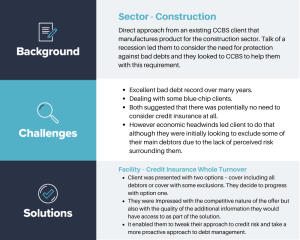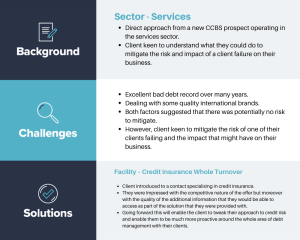So Graeme, what is Invoice Finance?
Invoice Finance is a product used to help maintain cashflow, it provides advances of up to 90% of a company’s debtor book – what customers owe you essentially – which provides you with a long-term cashflow solution. And as we all know, cashflow is critical for all businesses, at all times!
What are the benefits of invoice finance?
There are a lot of benefits – so many that it’s even overtaken overdrafts as the working capital solution of choice for many businesses and funders. For example, the only limit to the funds you can access is the total of the invoices you exchange – not like strict caps on bank loan lending policies. That means the product grows as your business grows, meaning it can provide a long-term solution. It can also nurture business growth as you’ll have a steady flow of cash rather than waiting for invoices to be paid before the funds are available, or banks to make lengthy funding decisions – so you can continue to build your business without any delays.
What types of businesses can access invoice finance?
It can really be used by any sized company from SME through to enterprise-sized businesses and there are even specialist IF providers which can support niche companies or specialist industries. For example, some lenders offer construction or contractual sector-specific lends to support businesses in certain sectors or with complex business models or financing.
What else can Invoice Finance be useful for?
It can also be used to support CapEx, acquisitions or buy-outs, or event-drive finance too. So if you’re going through a change, and you have concerns about its impact on your working capital, invoice finance can be a good solution to explore.
Can you tell us about a recent invoice finance deal you’ve been involved with?
It’s not a one-size-fits-all landscape so it’s really critical that you understand what will be required to implement Invoice Finance, what the risks are, and which funder can best meet your needs. We recently supported a longstanding client who was expanding operations into Australia after two successful expansions in the US and Canada. We found a global funder who could support them with a £200,000 Invoice Finance solution that gave them the cashflow headroom to drive forward their plans.
How can business owners find out more?
If this strike a chord with you, definitely get in touch with us. We can find out about your specific situation and give you honest guidance as to whether IF is the right solution for you, or whether something else would be a better fit for your circumstances.
Business Protection is not something that we generally talk to clients about (and not products that we offer) but following a recent meeting the whole topic of Business Protection came into much finer focus.
Some food for thought…
Key Person Insurance
- There are often key individuals that make a big contribution to the success of a business.
- Losing one can have a serious impact on the financial health of the business.
- Key Person Insurance is designed to help protect your business against just such an eventuality.
- SME insights (SME State Of The Nation research conducted by Legal & General): –
- 70% of business owners believe that they would cease trading in less than 2 years with the loss of a key person.
- 59% think that they would cease trading within 12 months.
- 60% of businesses said that they had 3 or more key people.
Ask yourself – how many key people are in your organisation and how would the business be impacted if it lost a key person or worse still key people? Would this cause you an issue?
If the answer to that question is yes, then please click here for advice from our trusted partners.
Income Protection
- For many business owners becoming unwell or suffering an accident which prevents them from working is a significant threat.
- Fortunately, insurance products do exist to protect you from the risk of loss of income.
- You could receive up to £25,000 per month.
- Dividends can count as income.
Ask yourself – statutory sick pay is £99.95 per week for a maximum of 28 weeks. If you were unable to work, could you survive on that amount.
If the answer to that question is no, then please click here for advice from our trusted partners.
Business Loan Protection
- If a business owner dies or suffers terminal illness, lenders may have the right to demand that any outstanding loans are paid back.
- Business Loan Protection can provide peace of mind because it provides a lump sum to cover your business loans. This can include commercial loans / mortgages as well as director’s loans and personal guarantees.
- SME insights (SME State Of The Nation research conducted by Legal & General):-
- 80% of business owners have not taken out any insurance to ensure that directors loans could be repaid.
Ask yourself – have any individuals provided guarantees for business borrowing? If the answer to that question is yes, then please then please click here for advice from our trusted partners.
Private Medical Insurance
- Business health insurance or private medical insurance (PMI) is a policy that provides access to private health care for small business owners , their employees and families.
- SME insights (SME State Of The Nation research conducted by Legal & General):-
- 47% of UK employees see medical insurance as a key part of an employee benefits package
Ask yourself – Might health insurance improve the wellbeing of your team and reduce absences?
If the answer to that question is yes, then please click here for advice from our trusted partners.

Lenders that have secured loans against a business’ assets – such as through an all assets debenture – may be unwilling to release the security when the business seeks additional funding. This means that businesses may find it difficult to obtain additional financing or refinance existing facilities, potentially jeopardising their growth prospects and long-term sustainability.
As financial professionals and business owners, it’s essential to understand the security issues surrounding CBILS loans and the impact this has on businesses. While there’s no easy solution, exploring alternative financing options or negotiating with lenders could be a viable option for some businesses.
One potential step forward is the ability to transfer CBILS loans between financial institutions. While this is not currently possible, it’s something that could be considered in the future to help businesses access the finance they need while maintaining existing security arrangements.
In the industry, we must work together to find solutions that support the growth and success of our clients. This may involve exploring alternative financing options, negotiating with lenders, or advocating for changes to the CBILS scheme to enable loan transfers. By doing so, we can help businesses navigate these uncertain times and emerge stronger on the other side.
As we sail through the turbulent seas of the current economic climate, most businesses require one thing to keep them afloat; working capital. It’s that essential fuel that keeps the engine running smoothly and propels growth. However, acquiring the necessary working capital has become increasingly challenging in recent times.
At CCBS we understand the significance of working capital and the hurdles businesses face in sourcing it. With that in mind, we have highlighted several effective solutions that have proven to be invaluable in navigating the current economic landscape. Below outlines the working capital solutions that we find most useful in these uncertain times.
Invoice Finance: Unlocking Your Cash Flow Potential
Invoicing finance emerges as a flexible and reliable solution that helps businesses unlock the value of their outstanding invoices. We all know the pain of waiting for payments? Well, invoice finance provides a solution by allowing businesses to access a portion of their unpaid invoices in advance. By bridging the gap between invoice issuance and payment, businesses can ensure a steady flow of working capital, enabling them to meet operational requirements, invest in growth initiatives, and seize new opportunities.
Asset Refinancing: Turning Dormant Assets into Cash
Have you ever thought about those valuable assets sitting on the balance sheet? Think machinery, equipment, or even property. Asset refinancing offers a smart way to leverage these dormant treasures for much-needed funds. By using your assets as collateral, you can secure a loan that injects vital working capital into your business. Not only does this provide an immediate cash flow boost, but it also optimises asset utilisation and enhances operational efficiency.
Secured and Unsecured Business Loans: Flexibility at Your Fingertips
Secured and unsecured business loans remain steadfast options for businesses seeking working capital. Secured loans, backed by property, offer favorable terms and speed of delivery. They provide a reliable and cost-effective funding source. On the other hand, unsecured loans come in handy for businesses that may not possess substantial assets to secure financing against. These loans provide flexibility and speed, allowing businesses to quickly access the funds they need to address immediate working capital needs.
At CCBS we take pride in our expertise in the field. Our mission is to match businesses with the right funders for their particular needs, helping structure the ideal solution. With our extensive network of funders who understand diverse industries and unique requirements, we ensure that businesses receive customised and comprehensive working capital solutions. In these uncertain times, having the right working capital solutions is crucial for business survival and growth.
Reach out to our team and we’ll be more than happy to explore how we can assist you or your client in securing the working capital it deserves. Contact us >>
Given recent headlines around business failures and the messages coming out of the funding market of a move onto a recession footing, discussions have turned to solutions to manage risks.
In today’s competitive business landscape, managing credit risk is crucial for the financial health and stability of companies. One effective strategy to mitigate credit risk is by securing bad debt insurance. This article explores the concept of credit risk, the importance of bad debt insurance, and the processing businesses can undertake to safeguard their financial interests.
Understanding Credit Risk
Credit risk refers to the potential loss a business may incur due to non-payment or delayed payment by its customers. It arises from extending credit to customers who may default on their payment obligations. For businesses, managing credit risk is vital to maintain cash flow, minimize financial losses, and ensure sustained operations.
The Importance of Bad Debt Insurance
Bad debt insurance, also known as trade credit insurance or accounts receivable insurance, provides protection against non-payment by customers due to insolvency, bankruptcy, or other defined events. It acts as a safeguard, allowing businesses to recover outstanding debts and mitigate the negative impact of customer default. Here are key benefits of bad debt insurance:
- Enhanced Cash Flow: Bad debt insurance provides a safety net by reimbursing a percentage of the unpaid amount, thus improving cash flow and minimizing the impact on working capital.
- Risk Diversification: By transferring credit risk to an insurance provider, businesses can diversify their risk exposure and protect against potential losses from customer defaults.
- Confidence in Customer Relationships: Having bad debt insurance coverage enables businesses to offer more flexible credit terms to customers, fostering stronger relationships and increasing sales opportunities.
- Improved Financing Opportunities: Lenders often consider bad debt insurance as a positive factor when assessing the creditworthiness of a business. Having coverage can enhance the chances of securing favorable financing terms.
To effectively manage credit risk and leverage bad debt insurance, processing businesses should undertake the following steps:
- Customer Due Diligence: Conduct thorough credit assessments before extending credit to customers. Consider factors such as credit history, financial stability, payment track record, and industry reputation. This helps identify potential credit risks and determine appropriate credit limits.
- Credit Terms and Policies: Establish clear and well-defined credit terms and policies. Communicate them to customers and ensure they understand their obligations. Specify payment terms, credit limits, and consequences for late or non-payment.
- Regular Monitoring and Evaluation: Continuously monitor customer payment behavior and promptly address any red flags. Establish an effective accounts receivable management system to track payments, send reminders, and escalate collection efforts when necessary.
- Credit Insurance Evaluation: Assess different bad debt insurance options available in the market. Compare coverage terms, exclusions, and premium costs. Work with an experienced insurance broker who can guide you through the selection process and recommend appropriate coverage for your business.
- Claims Management: Familiarise yourself with the claims process of your bad debt insurance provider. Understand the documentation requirements, claim submission procedures, and timelines. Promptly submit claims for eligible unpaid invoices to maximise recovery
- Ongoing Review: Regularly review and update your credit risk management and bad debt insurance strategies. Reassess credit limits, terms, and insurance coverage as your business grows or market conditions change. Stay informed about the creditworthiness of your customers and adjust your risk mitigation efforts accordingly.
Managing credit risk is vital for the financial stability and growth of processing businesses. By implementing effective credit risk management practices and securing bad debt insurance coverage, businesses can protect their cash flow, enhance customer relationships, and minimize losses arising from customer defaults. Conducting thorough due diligence, establishing clear credit policies, and working with reputable insurance providers are key steps to safeguard your business against credit risks.
Recent credit insurance deals we’ve completed:


See latest deals.
If this sounds like something your business would benefit from, contact us today for a no-oligation chat at info@ccbsg.co.uk or use our contact form.

So we’re delighted to announce our exciting new initiative to support local grassroots sports throughout 2023. As part of this we’ll be providing kit sponsorship, matchday sponsorship and organising several matchday hospitality events across various sports for a number of special teams.
The best part is, you can nominate a team for us to provide this support to. All you have to do is:
- Sign up to our mailing list (link on our homepage) and watch your inbox for nominations to open
- When nominations are open, tell us all about the team you want to nominate, a funny story related to the team, and the reason you think they deserve support this year
If you don’t know a team to nominate, please share with your networks as someone will know a group who could really benefit.
- Level of enquiries for SME credit and lending are high
- Liquidity still strong amongst funders committed to supporting SMEs
As recent articles report of a deceleration in demand for credit from SMEs in the UK, we’ve been delighted to find that SMEs in the North East are not only bucking the trend, but heading into 2023 with ambition, confidence and determination, as appetite for credit and lending has soared.
Resilient entrepreneurs are aggressively acquiring businesses, some building their investment portfolios, and others pivoting business models or trialling new products and services due to opportunities presented by the pandemic and its legacy.
Enquiries began to climb in summer 2022 and the demand continues to build, with our team predicting the level of enquiries will not wane in 2023. Whilst the 2022 Mini Budget and the subsequent upheaval did cause ripple effects, both business and lender side, the upward trend in enquiries had already begun and has further strengthened heading in to the new year.
Whilst many deals that would have been mainstream bankable deals in the recent past are no longer so straightforward, there is a steady demand and those with inclination and commitment – and the right support – will find alternative providers. In times of uncertainty clients look for assurances from their funding partners and whilst mainstream providers have become more reticent and unable to provide such guarantees, alternative solutions are increasingly available. With many businesses forced to turn to such alternatives, demand is strong, especially for asset finance/refinance and property deals.
Our advice to SMEs looking for credit and lending this year? Be open to alternatives.
We can help. Contact Steven Foley at steven@ccbsg.co.uk for an initial chat to find out how our experience and network can grow your business in 2023.
Launched on 6th April, the aim of the Recovery Loan Scheme is to create the next stage in the funding market; providing continued support to businesses impacted by Covid-19 as they prepare for the reduction in restrictions and return to trading. There are some key differences from the previous schemes, for starters the BIP (Business Interruption Payment) is gone – the element that covered interest and fees in the first 12 months.
Here’s what we know about these loans so far:
- You can borrow from £25,001 to £10,000,000 over six years
- There’s no limit based on your turnover (unlike CBILS)
- Eligibility isn’t affected if you already have a government-backed loan
- Scheme will run to 31st December 2021
Future plans
Very early feedback on the Recovery Loan Scheme is that it is focused more on future plans and less around historic serviceability from 2019. This is a significant change but time will tell what it means in practice. For many sectors and businesses working off 2019’s financial position has always been redundant so looking at future plans can only be beneficial. We’ll be staying close to this throughout and keeping you updated – talk to us early as this will hinge on being, as ever, the right fit for the right circumstance to the right funding option/partner at the right time.
Accredited lenders
There is only a small number of accredited lenders currently on the panel, but much like CBILS, we expect this number to increase over the coming weeks. Feedback from some funders is they’re holding back until May and June to launch. This just allows them to reset and reorganise around the new scheme, and the changes in criteria in line with the above.
Super Deduction
The Recovery Loan Scheme comes on top of the Super Deduction announced as part of the Budget. For two years from April 2021, a company’s investments in plant and machinery will qualify for a 130% capital allowance deduction, providing 25p off company tax bills for every £1 of qualifying spending on plant and machinery. The policy aims to spur post-pandemic growth and give the government more corporate profits to tax come 2023.
Looking at the detail as we stand, utilising Hire Purchase agreements to invest in new plant and machinery complies with the scheme. The treasury have clearly identified the longer term impact of the pandemic being stalled business investment. This scheme looks to redress this, in the hope of investment over the 2 year period leads to taxable profits in the years to come.
With the 2 schemes running, now is clearly the time to consider future plans. How can this help your business deliver on its plans? If you have any questions, contact me on the details below or via our contact form.
Matt Lister | Operations Director | Matt@ccbsg.co.uk
by Graeme Harrison
As we begin to emerge from what is hopefully our last national lockdown, and see the light at the end of this pandemic tunnel, will the funding world be going back to ‘normal’ as we knew it?
It’s been just over a year now since the word ‘normal’ became the most fluid in the English dictionary. During this time we’ve all had to adjust to several new ‘norms’, not only in our day to day lives, but also in our professional ones. The world of funding was no exception, with the government announcing schemes such as Bounce Back (BBLS) and the Coronavirus Business Interruption Loan (CBILS), as well as making words like ‘furlough’, previously new to most of us, seem very familiar and, well, normal.
Although the government’s furlough scheme has been (and continues to be) a lifeline to many businesses, it’s BBLS, and in particular CBILS, which have played a key role in the funding landscape throughout this pandemic.
Initially, the mainstream banks were given the unenviable task to deliver these loans without notice, and it must be said, worked hard to do what they could in very difficult circumstances. Following this, the independent market was able to gain accreditation, and CBILS backed lending started to appear in a multitude of shapes and sizes. Taking the form of asset finance, term loans, invoice finance or facility top-ups, CBILs helped maintain liquidity in the market and became a ‘normal’ way to structure a facility.
CBILS, however, has now come to an end and been replaced with the government’s new Recovery Loan. While the 80% guarantee from the government is still present in the new scheme, the key benefit of one years interest covered by the Business Interruption Payment (BIP), and in most cases a years capital repayment holiday is no longer a feature. And therefore, the debt is fully serviceable from drawdown. The Recovery Loan scheme will no doubt be a key component of the funding landscape over the coming months. But without the repayment holiday, could it also signify a return to traditional funding? Or in the context of this article, will we return to the old normal or continue down fresh, new, innovative paths? To help answer that, we need only look at the changing face of the funding landscape in recent months. We’ve seen banks jettison their smaller factoring books and others exit the invoice finance market all together, some lenders have restructured themselves in order to ‘rightsize’ the business and established lenders have tried to compete in the unsecured market only to fail. In and amongst all of this noise and repositioning, we’ve also seen the emergence of new funders break into the mainstream with products which offer quick, flexible funding solutions based solely on the strength of the people, project, or security. We’ve seen a growing appetite in the unsecured growth funding space whilst some of the traditional funders have broadened their offering as they look to gain a competitive edge in the market. Add into the mix the growing number of FinTechs which are now an ever-present disrupting force, whom will in all probability come out of the pandemic stronger than when they went in.
With all of this movement it may be fair to say that, in a funding context at least, ‘normal’ could be a thing of the past. Although there will always be a place for traditional forms of funding and the institutions which provide them, the market in general seems to be changing at a rate of knots. This is certainly not bad news for businesses, whom will have more options than ever as funders strive to provide innovative solutions in this space. However, they will likely require more guidance when exploring funding options to help navigate an ever-evolving market.
It will be interesting to see how the funding market, which for the last 12 months has arguably been over reliant on CBILS, will adjust and react as the country emerges from lockdown. Further, what part the aforementioned Recovery Loan will play in this adjustment? I suspect we may be hearing quite a bit about it in the coming months.
We are delighted to announce that we are now directly authorised by the Financial Conduct Authority.
Peter Cromarty, Managing Director at CCBS, explains more:
“This is another strategic step in our Roadmap and undoubtedly reinforces our credibility in provide structured commercial finance solutions to our clients. Whilst this will not change how we operate, it builds on the great relationships we already have with both our clients and panel of funders alike.
“In very difficult current market conditions this additional layer of approval stands us in good stead to help our business contacts in the turbulent months ahead.”
If you would like to talk to Peter and the team about a financial issue or challenge with your business, complete the contact page.

